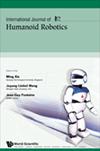基于人机交互的面向人工智能的用户界面设计与人类行为识别
IF 1.6
4区 计算机科学
Q4 ROBOTICS
引用次数: 0
摘要
本工作旨在探索基于深度学习的智能算法在人机交互系统中的应用,希望能够推动行为识别领域的人机交互系统的发展。首先,给出了人机交互系统的设计方案,重点介绍了机器人视觉定位系统的建立。然后,介绍了快速区域卷积神经网络(fast-RCNN)算法,并将其与深度卷积残差网络(ResNet101)相结合。提出了一种基于ResNet和长短期记忆网络的候选区域提取算法,并提出了一种用于空间上下文记忆的残余网络(ResNet)。这两种算法都应用于人机交互系统中。最后,对算法和人机交互系统的性能进行了分析和表征。结果表明,本文提出的候选区域提取算法能够显著降低训练集和测试集训练后的损失值。此外,该模型对应的准确率、召回率和[公式:见文]-值均在0.98以上,证明该模型具有较好的检测精度。空间上下文记忆ResNet在语音表达检测中表现出较好的准确性。单属性、双属性和多属性语音表达的检测准确率均在89%以上,检测精度较好。综上所述,人机交互系统在捕获目标物体方面表现出良好的性能,即使对于未标记的物体,相应的抓取成功率也达到95%。因此,本工作为智能优化算法在人机交互系统中的应用提供了理论基础和参考。本文章由计算机程序翻译,如有差异,请以英文原文为准。
Artificial Intelligence-Oriented User Interface Design and Human Behavior Recognition based on Human–Computer Nature Interaction
This work is to explore the application of intelligent algorithms based on deep learning in human–computer interaction systems, hoping to promote the development of human–computer interaction systems in the field of behavior recognition. Firstly, the design scheme of the human–computer interaction system is presented, and the establishment of the robot visual positioning system is emphasized. Then, the fast-region convolutional neural networks (fast-RCNN) algorithm is introduced, and it is combined with deep convolutional residual network (ResNet101). A candidate region extraction algorithm based on ResNet and long short-term memory network is proposed, and a residual network (ResNet) for spatial context memory is proposed. Both algorithms are employed in human–computer interaction systems. Finally, the performance of the algorithm and the human–computer interaction system are analyzed and characterized. The results show that the proposed candidate region extraction algorithm can significantly reduce the loss value of training set and test set after training. In addition, the corresponding accuracy, recall, and [Formula: see text]-value of the model are all above 0.98, which proves that the model has a good detection accuracy. Spatial context memory ResNet shows good accuracy in speech expression detection. The detection accuracy of single attribute, double attribute, and multi-attribute speech expression is above 89%, and the detection accuracy is good. In summary, the human–computer interaction system shows good performance in capturing target objects, even for unlabeled objects, the corresponding grasping success rate is 95%. Therefore, this work provides a theoretical basis and reference for the application of intelligent optimization algorithm in human–computer interaction system.
求助全文
通过发布文献求助,成功后即可免费获取论文全文。
去求助
来源期刊
CiteScore
3.50
自引率
13.30%
发文量
29
审稿时长
6 months
期刊介绍:
The International Journal of Humanoid Robotics (IJHR) covers all subjects on the mind and body of humanoid robots. It is dedicated to advancing new theories, new techniques, and new implementations contributing to the successful achievement of future robots which not only imitate human beings, but also serve human beings. While IJHR encourages the contribution of original papers which are solidly grounded on proven theories or experimental procedures, the journal also encourages the contribution of innovative papers which venture into the new, frontier areas in robotics. Such papers need not necessarily demonstrate, in the early stages of research and development, the full potential of new findings on a physical or virtual robot.
IJHR welcomes original papers in the following categories:
Research papers, which disseminate scientific findings contributing to solving technical issues underlying the development of humanoid robots, or biologically-inspired robots, having multiple functionality related to either physical capabilities (i.e. motion) or mental capabilities (i.e. intelligence)
Review articles, which describe, in non-technical terms, the latest in basic theories, principles, and algorithmic solutions
Short articles (e.g. feature articles and dialogues), which discuss the latest significant achievements and the future trends in robotics R&D
Papers on curriculum development in humanoid robot education
Book reviews.

 求助内容:
求助内容: 应助结果提醒方式:
应助结果提醒方式:


